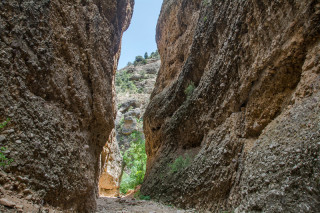Explorer Corps Marker: Sanpete County
Find the Marker
The Sanpete County marker is just outside the entrance to the Ephraim Co-Op Mercantile Association at 96 N Main Street in Ephraim. It highlights Maple Canyon, about 20 miles northwest of Ephraim; this unique conglomerate rock formation is very popular with rock climbers from all over the world.
GPS 39°21’41.0292”N 111°35’13.3872”W
Dig Deeper
Utah’s rocks come in many forms. There are boulders and sand grains, hoodoos and ledges, sandstone and basalts, an entire litany of geologic particulars on display throughout the state. And one of the most unique places in Utah is where geology meets outdoor adventure, in Sanpete County’s Maple Canyon Cretaceous Conglomerate.

Just look at the stony walls of Maple Canyon and you can start to get a feel for what the word “conglomerate” means. In geologic terms, a conglomerate is a form of rock that contains fragments of older rocks called clasts that are larger than two millimeters in diameter. Often, conglomerates look very pebbly – almost like concrete full of sand and gravel with a cementing mix of smaller particles. And in the case of Maple Canyon, the clasts are pretty big. The walls of the canyon are positively dotted with hand-sized cobbles.
Where did those cobbles come from? That story goes back to the Cretaceous Period, between 145 and 66 million years ago. During this time, a massive and long-lasting mountain-building event called the Sevier Orogeny was going on in Utah. This is what created so much of Utah’s gorgeous, exposed geology, bringing long-buried layers up above the surface.
But mountains aren’t places where sediment is being laid down, like a lake or an ocean. Mountains are eroded by the elements, especially water. As the Sevier Orogeny pushed older rocks up into mountains, erosion started to tear the components of those mountains back down again. Through millions upon millions of years of erosion, mountain streams transported broken-down sediments down the mountains to splay out in a broad fan. This wasn’t a small thing. In some places, the sediment deposited by the mountain streams piled up 15,000 feet deep. These sediments carried a great number of rounded cobbles, which then became hardened into conglomerate rock.
The constant grind of geologic change wasn’t done here. Those thick layers of conglomerate rock were lifted higher up as the topography of Utah continued to change. And just as water cut into the ancient mountains, streams and waterways carved out slots and canyons into the conglomerate. This is what made Maple Canyon, the present form of rocks that have had quite a busy history since the Cretaceous.
The unique geologic baskstory of Maple Canyon created a landscape that is like a dreamland for climbers. The large cobbles make great hand-holds, and so climbers of all skill levels strike out for Maple Canyon each year to test their skills on the walls. As they climb, they’re getting in touch with the depths of time, a course millions and millions of years in the making.
Want to Go Farther?
Maple Canyon offers year-round climbing; it’s popular with ice climbers as well.